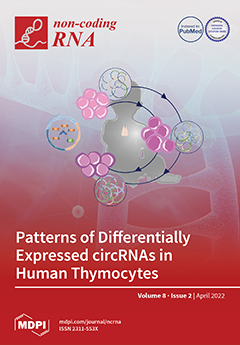MicroRNAs have been independently associated with asthma and COPD; however, it is unclear if microRNA associations will overlap when evaluating retrospective acute exacerbations.
Objective: We hypothesized that peripheral blood microRNAs would be associated with retrospective acute asthma exacerbations in a pediatric asthma cohort
[...] Read more.
MicroRNAs have been independently associated with asthma and COPD; however, it is unclear if microRNA associations will overlap when evaluating retrospective acute exacerbations.
Objective: We hypothesized that peripheral blood microRNAs would be associated with retrospective acute asthma exacerbations in a pediatric asthma cohort and that such associations may also be relevant to acute COPD exacerbations.
Methods: We conducted small-RNA sequencing on 374 whole-blood samples from children with asthma ages 6–14 years who participated in the Genetics of Asthma in Costa Rica Study (GACRS) and 450 current and former adult smokers with and without COPD who participated in the COPDGene study.
Measurements and Main Results: After QC, we had 351 samples and 649 microRNAs for Differential Expression (DE) analysis between the frequent (
n = 183) and no or infrequent exacerbation (
n = 168) groups in GACRS. Fifteen upregulated miRs had odds ratios (OR) between 1.22 and 1.59 for a doubling of miR counts, while five downregulated miRs had ORs between 0.57 and 0.8. These were assessed for generalization in COPDGene, where three of the upregulated miRs (miR-532-3p, miR-296-5p, and miR-766-3p) and two of the downregulated miRs (miR-7-5p and miR-451b) replicated. Pathway enrichment analysis showed MAPK and PI3K-Akt signaling pathways were strongly enriched for target genes of DE miRNAs and miRNAs generalizing to COPD exacerbations, as well as infection response pathways to various pathogens.
Conclusion: miRs (451b; 7-5p; 532-3p; 296-5p and 766-3p) associated with both childhood asthma and adult COPD exacerbations may play a vital role in airflow obstruction and exacerbations and point to shared genomic regulatory machinery underlying exacerbations in both diseases.
Full article






